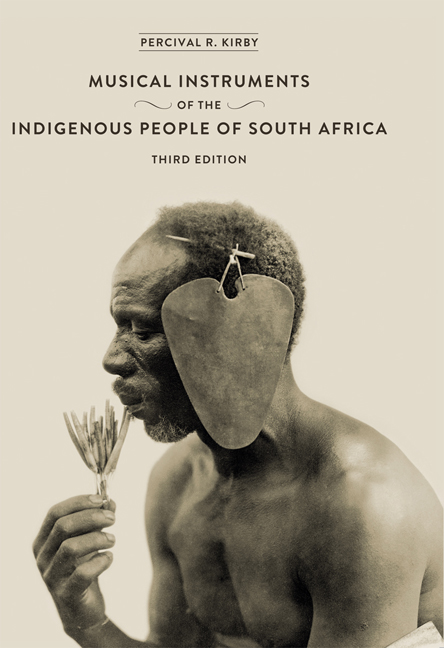Book contents
- Frontmatter
- Dedication
- Map
- Contents
- Foreword
- Preface to First Edition
- Preface to Second Edition
- Acknowledgements
- Acknowledgements to Third Edition
- List of Illustrations
- 1 Rattles and Clappers
- 2 Drums
- 3 Xylophones and ‘Sansas’
- 4 Bull-Roarers and Spinning-Disks
- 5 Horns and Trumpets
- 6 Whistles, Flutes, and Vibrating Reeds
- 7 Reed-Flute Ensembles
- 8 The ‘Gora’, A Stringed-Wind Instrument
- 9 Stringed Instruments
- 10 Bushman and Hottentot Violins and The ‘Ramkie’
- 11 Some European Instruments Played By Natives
- Appendix
- Addenda
- Index
7 - Reed-Flute Ensembles
Published online by Cambridge University Press: 21 April 2018
- Frontmatter
- Dedication
- Map
- Contents
- Foreword
- Preface to First Edition
- Preface to Second Edition
- Acknowledgements
- Acknowledgements to Third Edition
- List of Illustrations
- 1 Rattles and Clappers
- 2 Drums
- 3 Xylophones and ‘Sansas’
- 4 Bull-Roarers and Spinning-Disks
- 5 Horns and Trumpets
- 6 Whistles, Flutes, and Vibrating Reeds
- 7 Reed-Flute Ensembles
- 8 The ‘Gora’, A Stringed-Wind Instrument
- 9 Stringed Instruments
- 10 Bushman and Hottentot Violins and The ‘Ramkie’
- 11 Some European Instruments Played By Natives
- Appendix
- Addenda
- Index
Summary
THE first musical instruments of South Africa to be described by travellers were, so far as I can discover, flutes of reed which were played by bands of performers, each of whom was responsible for a single note. I have elsewhere dealt fully with the history, distribution, manufacture, and use of the instruments employed in these ensembles, giving in full practically every reference of importance to them from the earliest times to the present. I shall therefore epitomize here the more salient facts relating to them.
In 1497 Vasco da Gama, on landing at Cape St. Blaise, near Mossel Bay, was greeted by a band of Cape Hottentots who performed upon four or five flutes of reed. The survivors of the ill-fated S. João Baptista, wrecked in 1622 off the south coast of Africa, probably heard Cape Hottentots performing upon reed-flutes. Bogaert in 1711, and Valentyn in 1726, also described reed-flute ensembles of the Cape Hottentots. None of these descriptions, however, give us details, although it is obvious that the bands were identical with those to be mentioned next.
The first description of the reed-flute ensemble among the Nama Hottentots is that of Peter van Meerhoff, 1661, and here we see, for the first time in history, something of its true nature. There were between one and two hundred flute-players, each with a hollow reed in his hand, who danced in a circle, blowing upon their instruments, while in the centre was a man, the ‘master of ceremonies’, holding a long stick. The sound of the reeds, which were played in harmony, was, according to van Meerhoff, like that of trumpets. Dapper, in 1668, and Ogilby, in 1670, echo van Meerhoff 's description, and Schreyer (1669–77) merely mentions the Nama flutes; but the report of the expedition to Namaqualand of Simon Van der Stel in 1685 gives us fresh information. The Nama brought out their band of reed-flutes in honour of Van der Stel's birthday.
- Type
- Chapter
- Information
- The Musical Instruments of the Indigenous People of South Africa , pp. 192 - 231Publisher: Wits University PressPrint publication year: 2013



